回归Java基础:LinkedBlockingQueue阻塞队列解析
整理了阻塞队列LinkedBlockingQueue的学习笔记,希望对大家有帮助。有哪里不正确,欢迎指出,感谢。
LinkedBlockingQueue的概述
LinkedBlockingQueue的继承体系图
我们先来看看LinkedBlockingQueue的继承体系。 使用IntelliJ IDEA查看类的继承关系图形
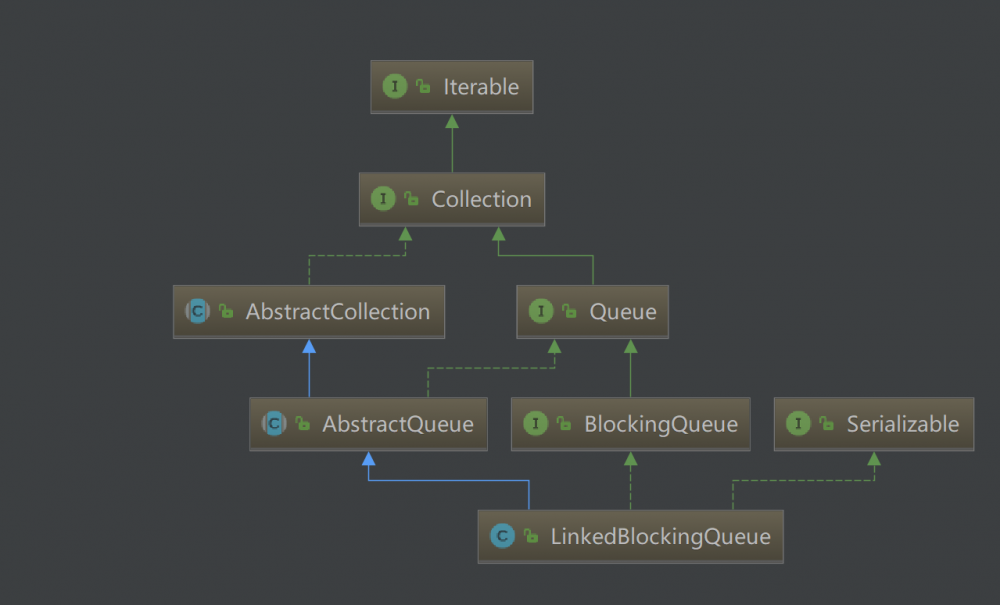
- 蓝色实线箭头是指类继承关系
- 绿色箭头实线箭头是指接口继承关系
- 绿色虚线箭头是指接口实现关系。
LinkedBlockingQueue实现了序列化接口 Serializable,因此它有序列化的特性。 LinkedBlockingQueue实现了BlockingQueue接口,BlockingQueue继承了Queue接口,因此它拥有了队列Queue相关方法的操作。
LinkedBlockingQueue的类图
类图来自Java并发编程之美

LinkedBlockingQueue主要特性:
- LinkedBlockingQueue底层数据结构为单向链表。
- LinkedBlockingQueue 有两个Node节点,一个head节点,一个tail节点,只能从head取元素,从tail添加元素。
- LinkedBlockingQueue 容量是一个原子变量count,它的初始值为0。
- LinkedBlockingQueue有两把ReentrantLock的锁,一把控制元素入队,一把控制出队,保证在并发情况下的线程安全。
- LinkedBlockingQueue 有两个条件变量,notEmpty 和 notFull。它们内部均有一个条件队列,存放着出入队列被阻塞的线程,这其实是生产者-消费者模型。
LinkedBlockingQueue的重要成员变量
//容量范围,默认值为 Integer.MAX_VALUE private final int capacity; //当前队列元素个数 private final AtomicInteger count = new AtomicInteger(); //头结点 transient Node<E> head; //尾节点 private transient Node<E> last; //take, poll等方法的可重入锁 private final ReentrantLock takeLock = new ReentrantLock(); //当队列为空时,执行出队操作(比如take )的线程会被放入这个条件队列进行等待 private final Condition notEmpty = takeLock.newCondition(); //put, offer等方法的可重入锁 private final ReentrantLock putLock = new ReentrantLock(); //当队列满时, 执行进队操作( 比如put)的线程会被放入这个条件队列进行等待 private final Condition notFull = putLock.newCondition(); 复制代码
LinkedBlockingQueue的构造函数
LinkedBlockingQueue有三个构造函数:
- 无参构造函数,容量为Integer.MAX
public LinkedBlockingQueue() {
this(Integer.MAX_VALUE);
}
复制代码
- 设置指定容量的构造器
public LinkedBlockingQueue(int capacity) {
if (capacity <= 0) throw new IllegalArgumentException();
//设置队列大小
this.capacity = capacity;
//new一个null节点,head、tail节点指向该节点
last = head = new Node<E>(null);
}
复制代码
- 传入集合,如果调用该构造器,容量默认也是Integer.MAX_VALUE
public LinkedBlockingQueue(Collection<? extends E> c) {
//调用指定容量的构造器
this(Integer.MAX_VALUE);
//获取put, offer的可重入锁
final ReentrantLock putLock = this.putLock;
putLock.lock();
try {
int n = 0;
//循环向队列中添加集合中的元素
for (E e : c) {
if (e == null)
throw new NullPointerException();
if (n == capacity)
throw new IllegalStateException("Queue full");
//将队列的last节点指向该节点
enqueue(new Node<E>(e));
++n;
}
//更新容量值
count.set(n);
} finally {
//释放锁
putLock.unlock();
}
}
复制代码
LinkedBlockingQueue底层Node类
Node源码
static class Node<E> {
// 当前节点的元素值
E item;
// 下一个节点的索引
Node<E> next;
//节点构造器
Node(E x) {
item = x;
}
}
复制代码
LinkedBlockingQueue的节点符合单向链表的数据结构要求:
- 一个成员变量为当前节点的元素值
- 一个成员变量是下一节点的索引
- 构造方法的唯一参数节点元素值。
Node节点图
item表示当前节点的元素值,next表示指向下一节点的指针
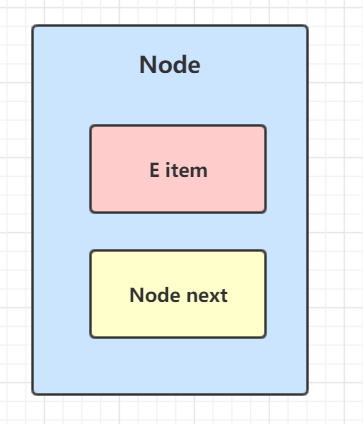
LinkedBlockingQueue常用操作
offer操作
入队方法,其实就是向队列的尾部插入一个元素。如果元素为空,抛出空指针异常。如果队列已满,则丢弃当前元素,返回false,它是 非阻塞的 。如果队列空闲则插入成功返回true。
offer源代码
offer方法源码如下:
public boolean offer(E e) {
//为空直接抛空指针
if (e == null) throw new NullPointerException();
final AtomicInteger count = this.count;
//如果当前队列满了的话,直接返回false
if (count.get() == capacity)
return false;
int c = -1;
//构造新节点
Node<E> node = new Node<E>(e);
获取put独占锁
final ReentrantLock putLock = this.putLock;
putLock.lock();
try {
//判断队列是否已满
if (count.get() < capacity) {
//进队列
enqueue(node);
//递增元素计数
c = count.getAndIncrement();
//如果元素入队,还有空闲,则唤醒notFull条件队列里被阻塞的线程
if (c + 1 < capacity)
notFull.signal();
}
} finally {
//释放锁
putLock.unlock();
}
//如果容量为0,则
if (c == 0)
//激活 notEmpty 的条件队列,唤醒被阻塞的线程
signalNotEmpty();
return c >= 0;
}
复制代码
enqueue方法源码如下:
private void enqueue(Node<E> node) {
//从尾节点加进去
last = last.next = node;
}
复制代码
为了形象生动,我们用一张图来看看往队列里依次放入元素A和元素B。图片参考来源 【细谈Java并发】谈谈LinkedBlockingQueue
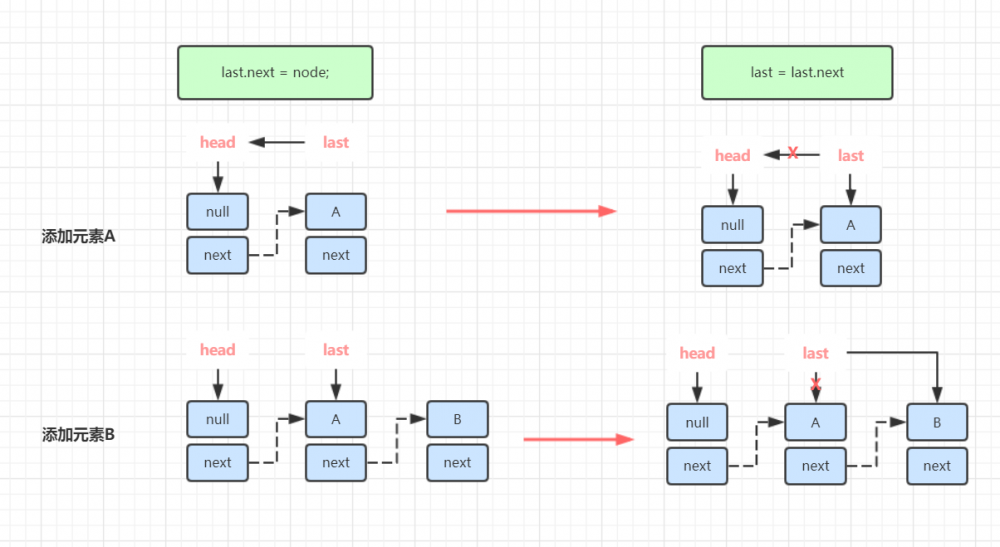
signalNotEmpty方法源码如下
private void signalNotEmpty() {
//获取take独占锁
final ReentrantLock takeLock = this.takeLock;
takeLock.lock();
try {
//唤醒notEmpty条件队列里被阻塞的线程
notEmpty.signal();
} finally {
//释放锁
takeLock.unlock();
}
}
复制代码
offer执行流程图
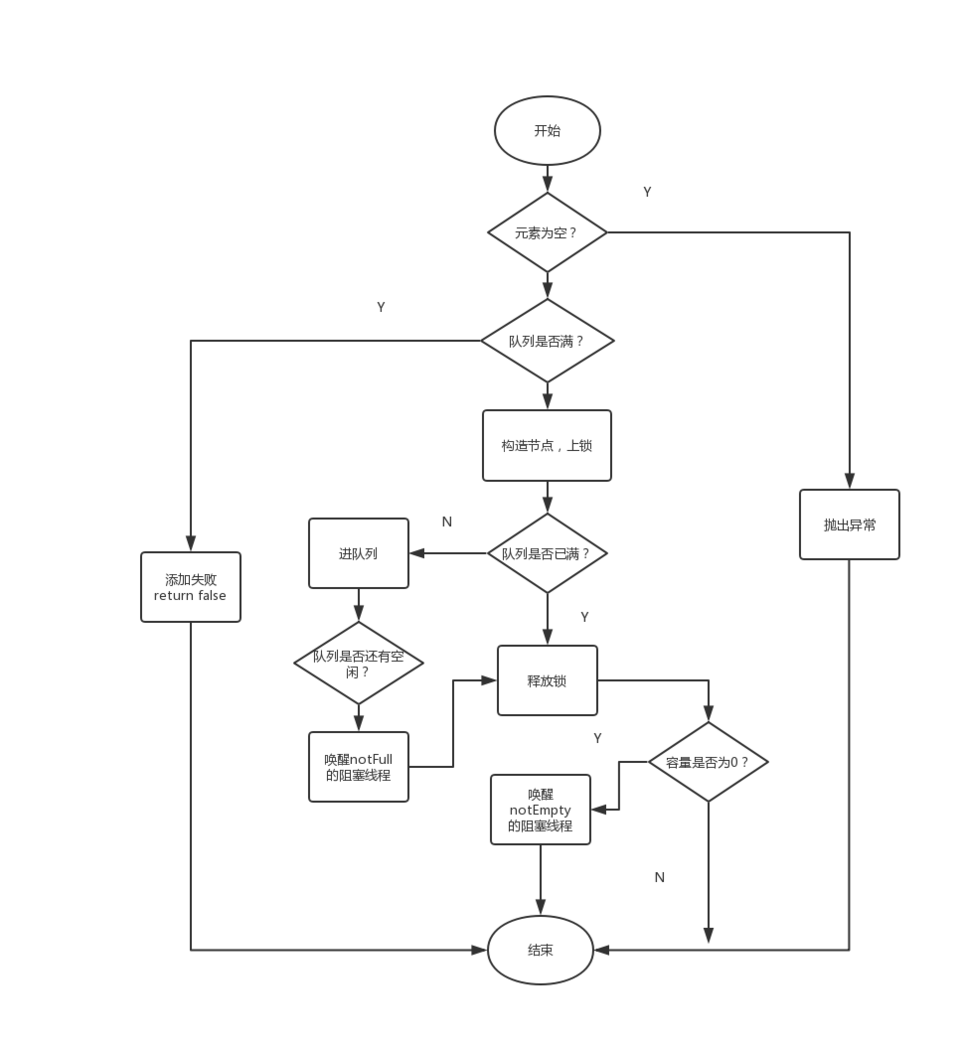
基本流程:
- 判断元素是否为空,如果是,就抛出空指针异常。
- 判读队列是否已满,如果是,添加失败,返回false。
- 如果队列没满,构造Node节点,上锁。
- 判断队列是否已满,如果队列没满,Node节点在队尾加入队列待。
- 加入队列后,判断队列是否还有空闲,如果是,唤醒notFull的阻塞线程。
- 释放完锁后,判断容量是否为空,如果是,唤醒notEmpty的阻塞线程。
put操作
put方法也是向队列尾部插入一个元素。如果元素为null,抛出空指针异常。如果队列己满则阻塞当前线程,直到队列有空闲插入成功为止。如果队列空闲则插入成功,直接返回。如果在阻塞时被其他线程设置了中断标志, 则被阻塞线程会抛出 InterruptedException 异常而返回。
put源代码
public void put(E e) throws InterruptedException {
////为空直接抛空指针异常
if (e == null) throw new NullPointerException();
int c = -1;
// 构造新节点
Node<E> node = new Node<E>(e);
//获取putLock独占锁
final ReentrantLock putLock = this.putLock;
final AtomicInteger count = this.count;
//获取独占锁,它跟lock的区别,是可以被中断
putLock.lockInterruptibly();
try {
//队列已满线程挂起等待
while (count.get() == capacity) {
notFull.await();
}
//进队列
enqueue(node);
//递增元素计数
c = count.getAndIncrement();
//如果元素入队,还有空闲,则唤醒notFull条件队列里被阻塞的线程
if (c + 1 < capacity)
notFull.signal();
} finally {
//释放锁
putLock.unlock();
}
//如果容量为0,则
if (c == 0)
//激活 notEmpty 的条件队列,唤醒被阻塞的线程
signalNotEmpty();
}
复制代码
put流程图
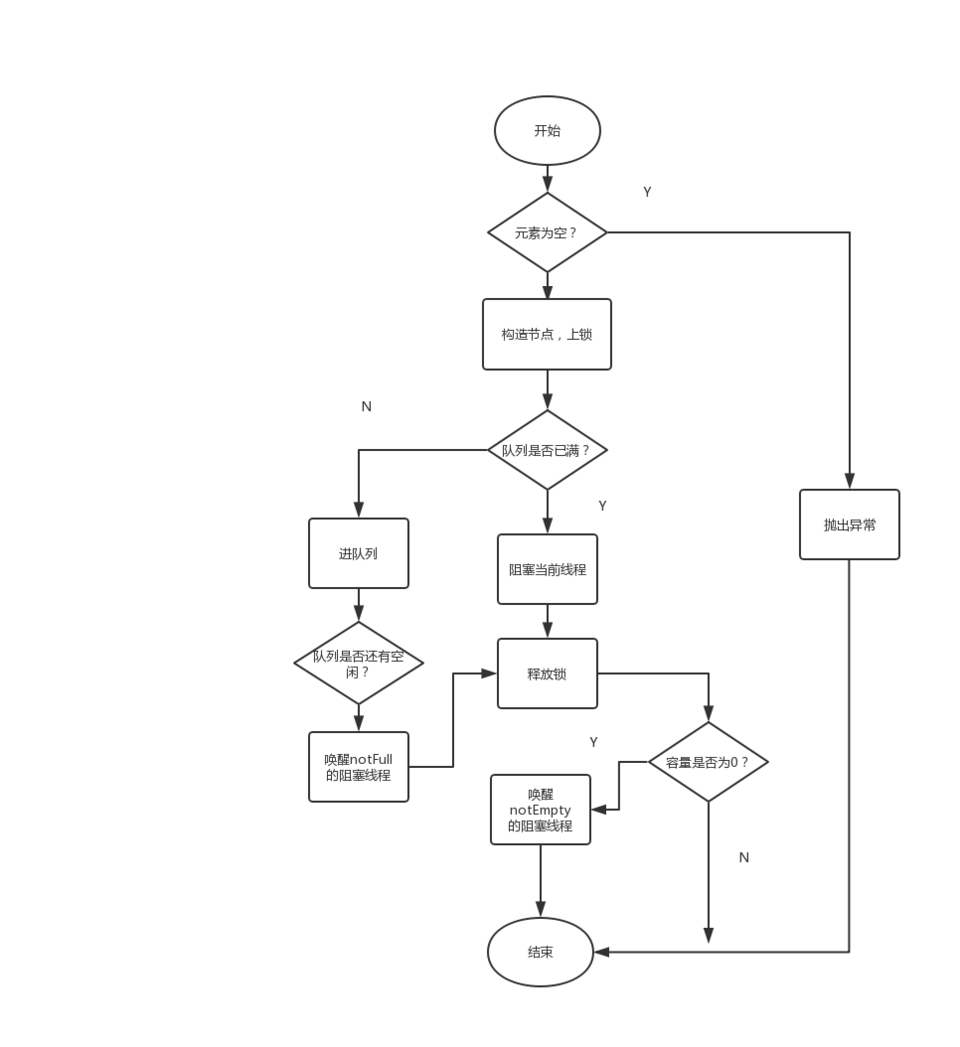
基本流程:
- 判断元素是否为空,如果是就抛出空指针异常。
- 构造Node节点,上锁(可中断锁)
- 判断队列是否已满,如果是,阻塞当前线程,一直等待。
- 如果队列没满,Node节点在队尾加入队列。
- 加入队列后,判断队列是否还有空闲,如果是,唤醒notFull的阻塞线程。
- 释放完锁后,判断容量是否为空,如果是,唤醒notEmpty的阻塞线程。
poll操作
从队列头部获取并移除一个元素, 如果队列为空则返回 null, 该方法是不阻塞的。
poll源代码
poll方法源代码
public E poll() {
final AtomicInteger count = this.count;
//如果队列为空,返回null
if (count.get() == 0)
return null;
E x = null;
int c = -1;
//获取takeLock独占锁
final ReentrantLock takeLock = this.takeLock;
takeLock.lock();
try {
//如果队列不为空,则出队,并递减计数
if (count.get() > 0) {
x = dequeue();
c = count.getAndDecrement();
////容量大于1,则激活 notEmpty 的条件队列,唤醒被阻塞的线程
if (c > 1)
notEmpty.signal();
}
} finally {
//释放锁
takeLock.unlock();
}
if (c == capacity)
//唤醒notFull条件队列里被阻塞的线程
signalNotFull();
return x;
}
复制代码
dequeue方法源代码
//出队列
private E dequeue() {
//获取head节点
Node<E> h = head;
//获取到head节点指向的下一个节点
Node<E> first = h.next;
//head节点原来指向的节点的next指向自己,等待下次gc回收
h.next = h; // help GC
// head节点指向新的节点
head = first;
// 获取到新的head节点的item值
E x = first.item;
// 新head节点的item值设置为null
first.item = null;
return x;
}
复制代码
为了形象生动,我们用一张图来描述出队过程。图片参考来源 【细谈Java并发】谈谈LinkedBlockingQueue

signalNotFull方法源码
private void signalNotFull() {
//获取put独占锁
final ReentrantLock putLock = this.putLock;
putLock.lock();
try {
////唤醒notFull条件队列里被阻塞的线程
notFull.signal();
} finally {
//释放锁
putLock.unlock();
}
}
复制代码
poll流程图
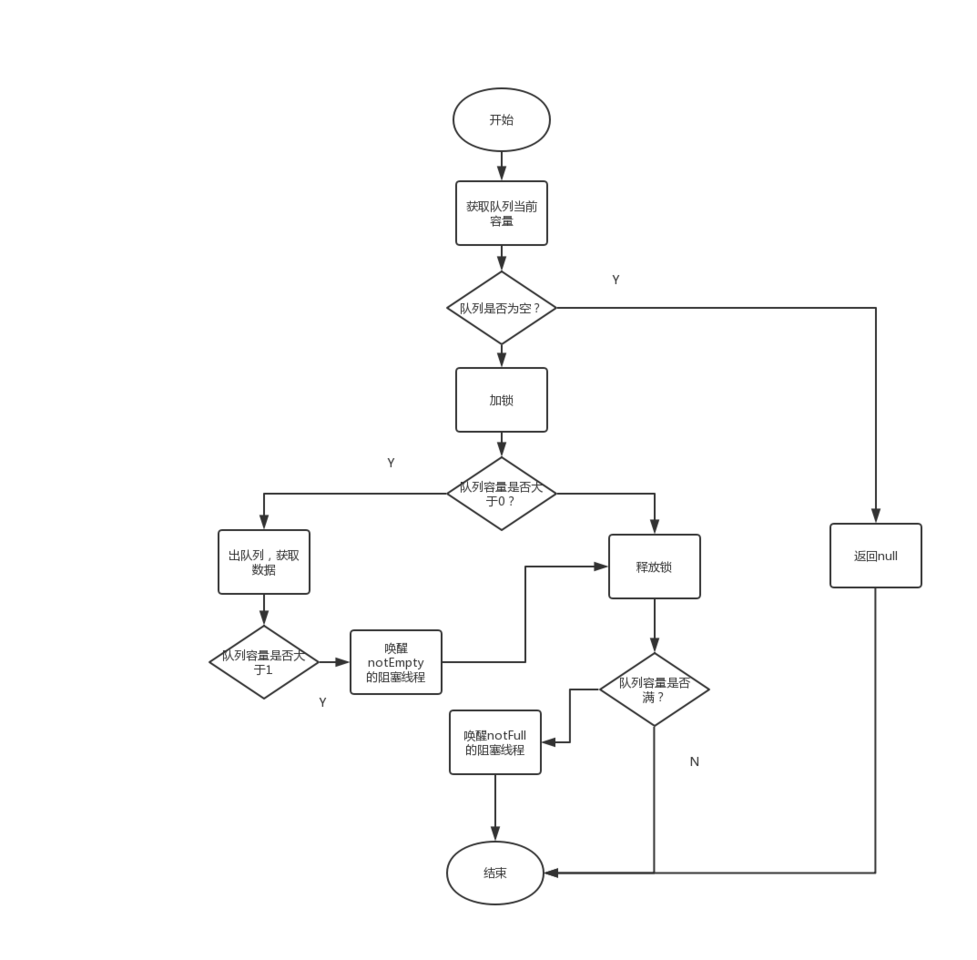
基本流程:
- 判断元素是否为空,如果是,就返回null。
- 加锁
- 判断队列是否有元素,如果没有,释放锁
- 如果队列有元素,则出队列,获取数据,容量计数器减一。
- 判断此时容量是否大于1,如果是,唤醒notEmpty的阻塞线程。
- 释放完锁后,判断容量是否满,如果是,唤醒notFull的阻塞线程。
peek操作
获取队列头部元素但是不从队列里面移除它,如果队列为空则返回 null。 该方法是不 阻塞的。
peek源代码
public E peek() {
//队列容量为0,返回null
if (count.get() == 0)
return null;
//获取takeLock独占锁
final ReentrantLock takeLock = this.takeLock;
takeLock.lock();
try {
Node<E> first = head.next;
//判断first是否为null,如果是直接返回
if (first == null)
return null;
else
return first.item;
} finally {
//释放锁
takeLock.unlock();
}
}
复制代码
peek流程图
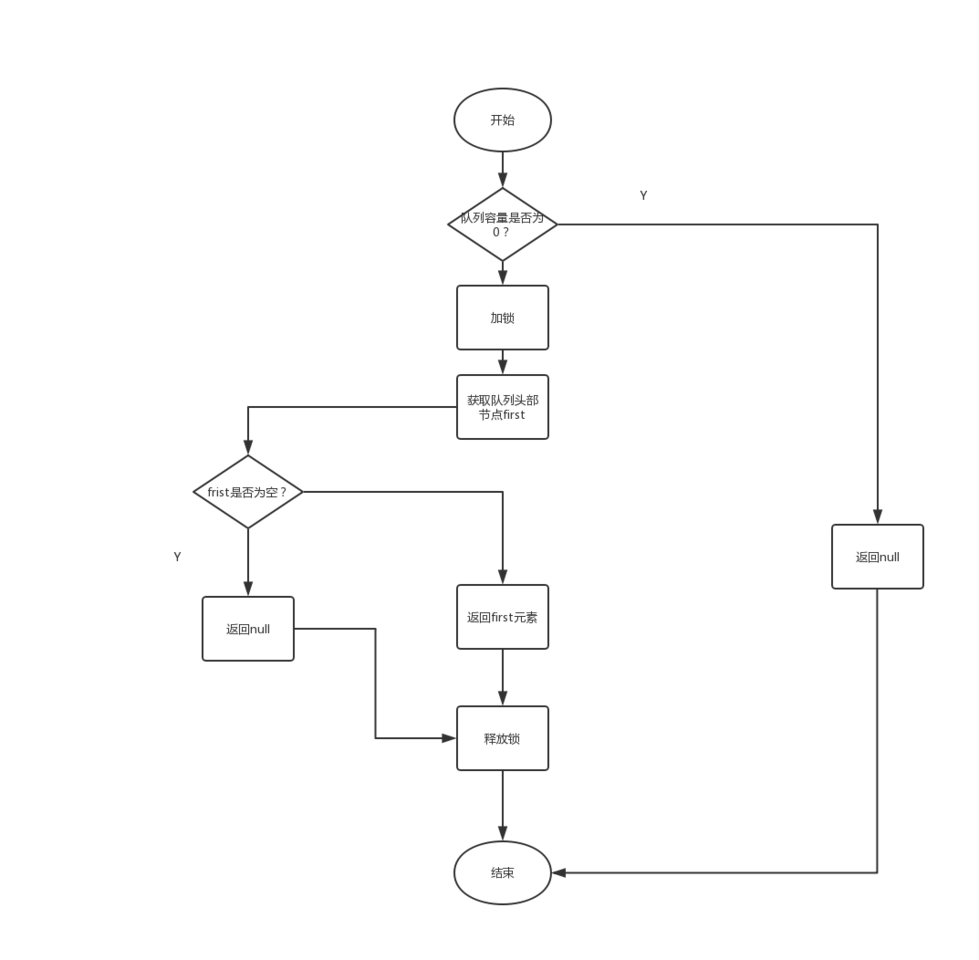
基本流程:
- 判断队列容量大小是否为0,如果是,就返回null。
- 加锁
- 获取队列头部节点first
- 判断节点first是否为null,是的话,返回null。
- 如果fist不为null,返回节点first的元素。
- 释放锁。
take操作
获取当前队列头部元素并从队列里面移除它。 如果队列为空则阻塞当前线程直到队列 不为空然后返回元素,如果在阻塞时被其他线程设置了中断标志, 则被阻塞线程会抛出 InterruptedException 异常而返回。
take源代码
public E take() throws InterruptedException {
E x;
int c = -1;
final AtomicInteger count = this.count;
//获取takeLock独占锁
final ReentrantLock takeLock = this.takeLock;
//获取独占锁,它跟lock的区别,是可以被中断
takeLock.lockInterruptibly();
try {
//当前队列为空,则阻塞挂起
while (count.get() == 0) {
notEmpty.await();
}
//)出队并递减计数
x = dequeue();
c = count.getAndDecrement();
if (c > 1)
//激活 notEmpty 的条件队列,唤醒被阻塞的线程
notEmpty.signal();
} finally {
//释放锁
takeLock.unlock();
}
if (c == capacity)
//激活 notFull 的条件队列,唤醒被阻塞的线程
signalNotFull();
return x;
}
复制代码
take流程图
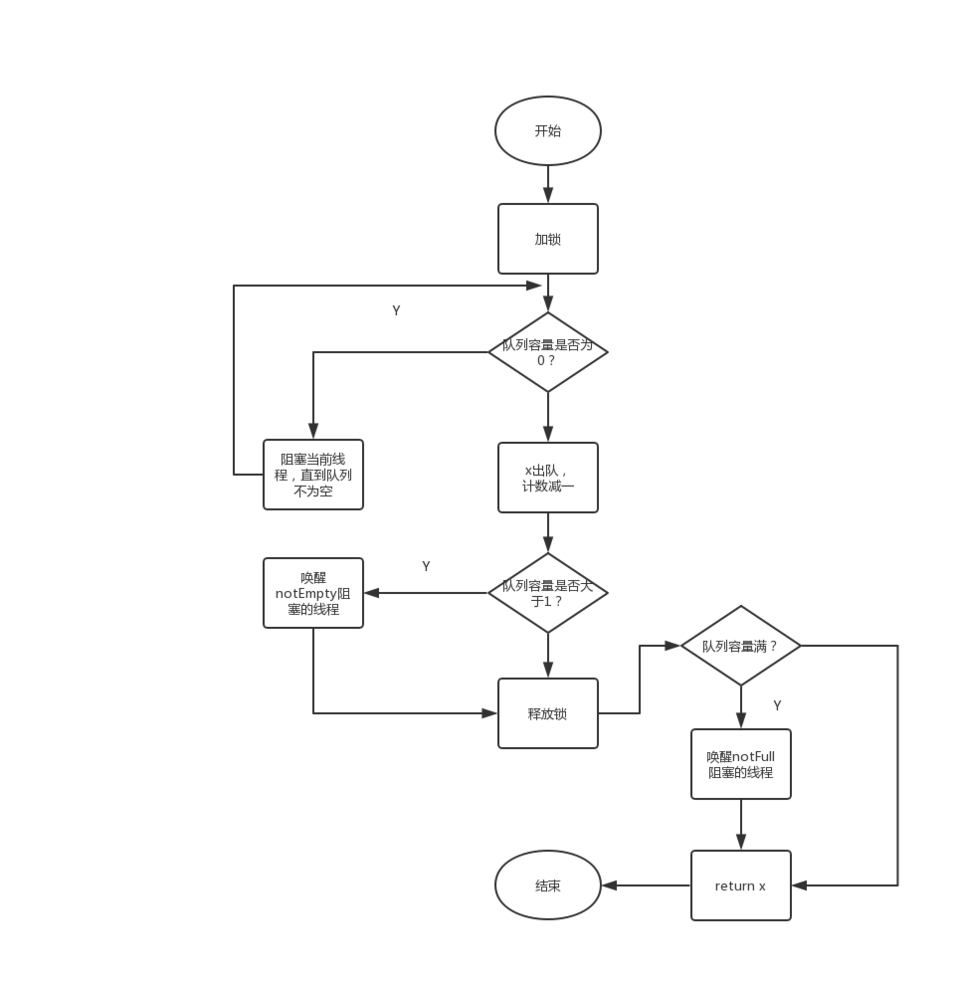
基本流程:
- 加锁
- 判断队列容量大小是否为0,如果是,阻塞当前线程,直到队列不为空。
- 如果队列容量大小大于0,节点出队列,获取元素x,计数器减一。
- 判断队列容量大小是否大于1,如果是,唤醒notEmpty的阻塞线程。
- 释放锁。
- 判断队列容量是否已满,如果是,唤醒notFull的阻塞线程。
- 返回出队元素x
remove操作
删除队列里面指定的元素,有则删除并返回 true,没有则返回 false。
remove方法源代码
public boolean remove(Object o) {
//为空直接返回false
if (o == null) return false;
//双重加锁
fullyLock();
try {
//边历队列,找到元素则删除并返回true
for (Node<E> trail = head, p = trail.next;
p != null;
trail = p, p = p.next) {
if (o.equals(p.item)) {
//执行unlink操作
unlink(p, trail);
return true;
}
}
return false;
} finally {
//解锁
fullyUnlock();
}
}
复制代码
双重加锁,fullyLock方法源代码
void fullyLock() {
//putLock独占锁加锁
putLock.lock();
//takeLock独占锁加锁
takeLock.lock();
}
复制代码
unlink方法源代码
void unlink(Node<E> p, Node<E> trail) {
p.item = null;
trail.next = p.next;
if (last == p)
last = trail;
//如果当前队列满 ,则删除后,也不忘记唤醒等待的线程
if (count.getAndDecrement() == capacity)
notFull.signal();
}
复制代码
fullyUnlock方法源代码
void fullyUnlock() {
//与双重加锁顺序相反,先解takeLock独占锁
takeLock.unlock();
putLock.unlock();
}
复制代码
remove流程图
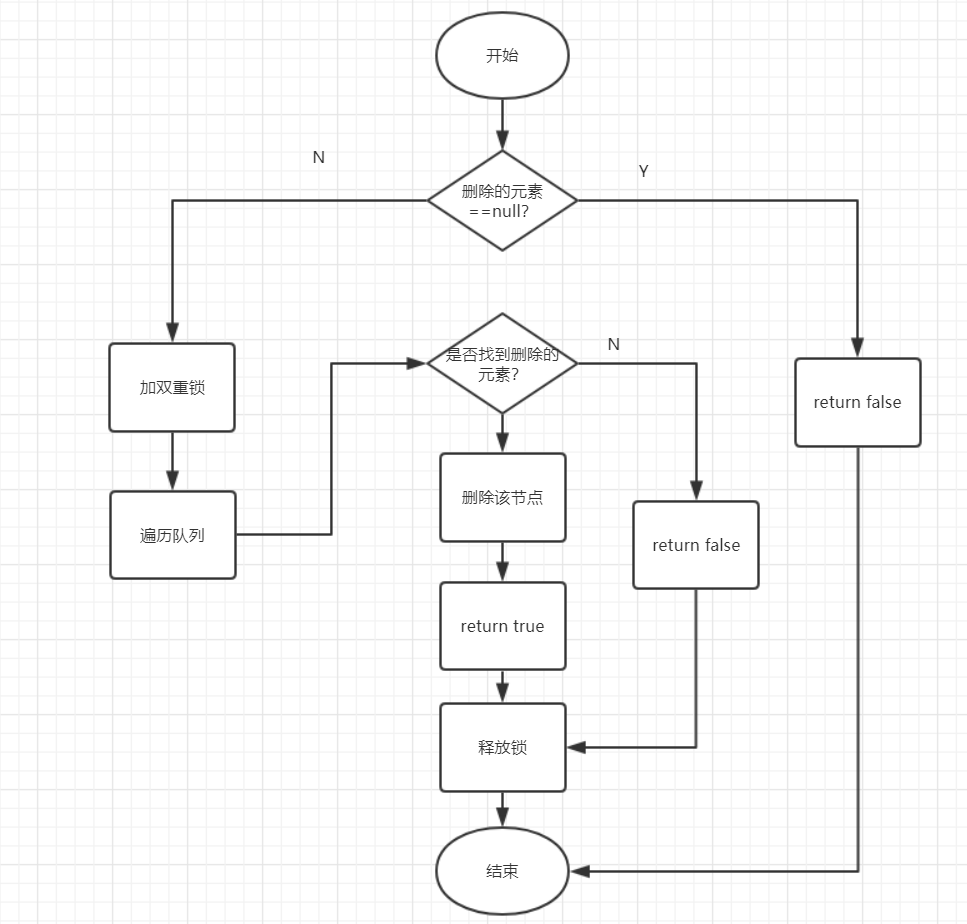
基本流程
- 判断要删除的元素是否为空,是就返回false。
- 如果要删除的元素不为空,加双重锁
- 遍历队列,找到要删除的元素,如果找不到,返回false。
- 如果找到,删除该节点,返回true。
- 释放锁
size操作
获取当前队列元素个数。
public int size() {
return count.get();
}
复制代码
由于进行出队、入队操作时的 count是加了锁的,所以结果相比ConcurrentLinkedQueue 的 size 方法比较准确。
总结
- LinkedBlockingQueue底层通过单向链表实现。
- 它有头尾两个节点,入队操作是从尾节点添加元素,出队操作是对头节点进行操作。
- 它的容量是原子变量count,保证szie获取的准确性。
- 它有两把独占锁,保证了队列操作原子性。
- 它的两把锁都配备了一个条件队列,用来存放阻塞线程,结合入队、出队操作实现了一个生产消费模型。
Java并发编程之美中,有一张图惟妙惟肖描述了它,如下图:
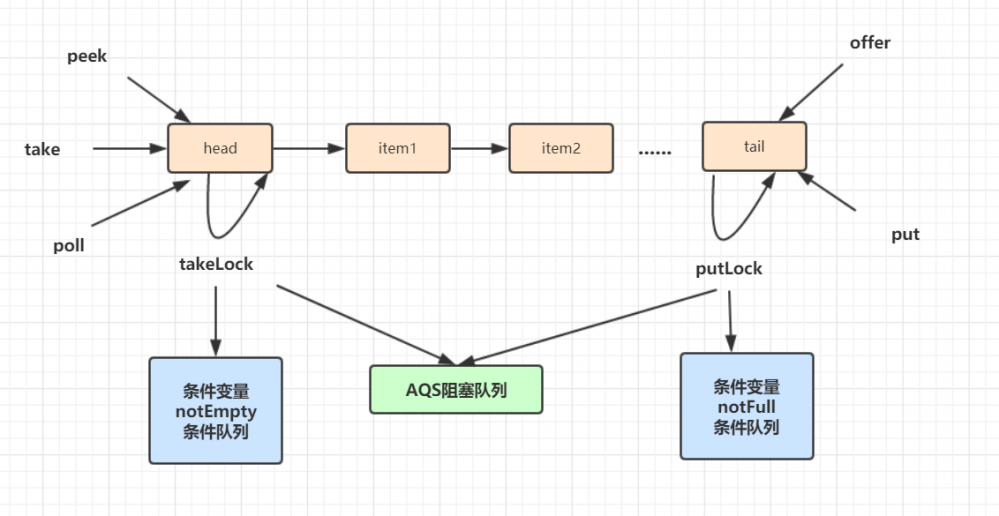











![[HBLOG]公众号](https://www.liuhaihua.cn/img/qrcode_gzh.jpg)

